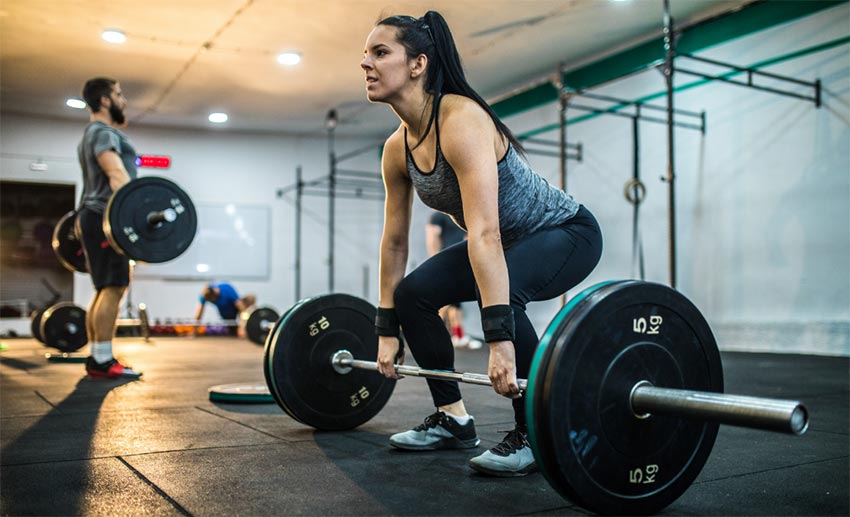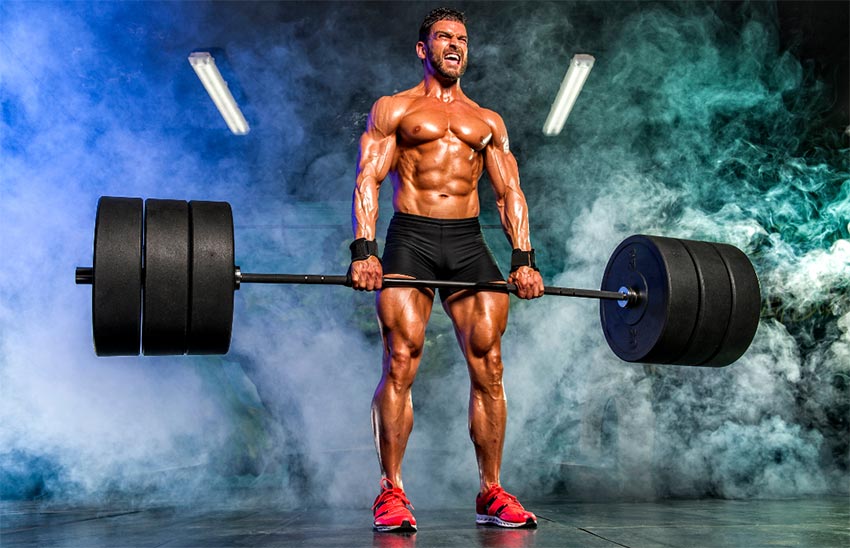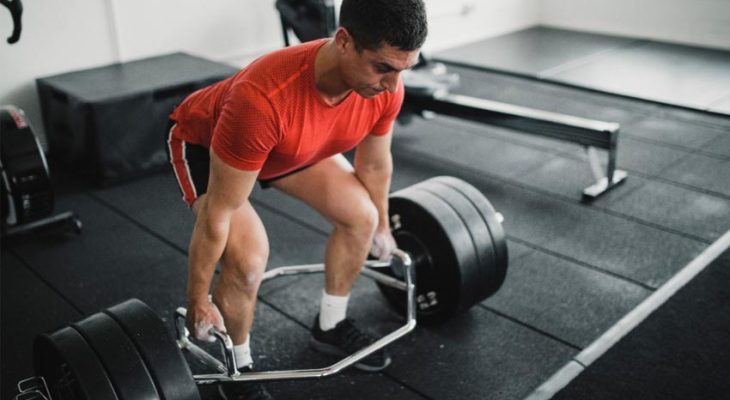The standard weight of a deadlift bar is 44 pounds, equivalent to approximately 20 kilograms.
When you’re lifting weights, knowing how much a deadlift bar weighs is important as it adds up to the overall weight you lift. Knowing how much you’re lifting in total will prevent injuries, help you track your weight-lifting progress, and ensure you know what you’re talking about when loading the weights onto the deadlift bar.
Besides deadlifts, the same type of bar is used for squats and can be used for various exercises, such as hip thrusts. Therefore, down below, you will find all about the deadlift bar weight, types of deadlift bars, and what makes the perfect deadlift, so keep on reading!
How Much Does a Deadlift Bar Weigh?
One great thing about deadlift bars is that they come in standard weights all around the world. Therefore, no matter where you are and in which gym you’re working out when you see a deadlift bar, you’ll know approximately its weight.
Deadlift bars weigh 44 pounds which is 20 kilograms. That’s the weight of the bar alone without any added weight. The weight is distributed by specific standards set by the International Powerlifting Federation (IPF). Thanks to the IPF, we can find the same deadlift bars in both competitions and training.
However, keep in mind that there are certain variations of the bars, whereas certain deadlift bars that can be used for both squats and deadlifts can weigh about 55 pounds, which is 25 kilograms. But it’s very rare to come across such bars.
There is also a difference in bars made for men and women. Men’s deadlift bars are the standard 44 pounds (20 kilograms) bars, whilst women’s bars are 33 pounds (15 kilograms).
Why Deadlift Bar Weight Matters
Knowing a deadlift bar’s weight will help you know the total weight you’re lifting during the deadlift exercise. Even before you add weight plates to the bar, it’s important to include the weight of the bar so you don’t end up adding more weight than you can lift.
Not knowing the deadlift bar’s weight and not including it in the calculation of the weight you’re about to lift can lead to injuries.
Therefore, knowing that a deadlift bar is almost always 20kg, if you’d like to lift 60kg for example, you only need a 20kg plate on each side of the bar to make it 60 kg in total weight.
Many people overlook the weight of the bar and only calculate the added weight to the bar. This isn’t the correct way so if you’re tracking progress, trying to compete, or breaking down a PR, it’s important to calculate the weight correctly by including the bar’s weight in the calculation.
Types of Bars Used for Deadlifts
Besides the traditional and most common deadlift bar that’s regulated by the IPF, there’s also a trap bar, known as a hex bar. This type of bar is named after its shape, which allows weight lifters to enter inside the bar to lift the weight.

The weight goes on the sides and the biggest benefit of the hex bar is the handles that make it easier to hold a comfortable grip during the exercise. This usually allows weight lifters to add more weight, stay more comfortable during a deadlift, avoid common back injuries associated with standard deadlifts, and even set better PRs.
The power bar is another type of a bar used for deadlifts, being 2.2 meters long and being very rigid, ensuring it holds the biggest weights people can lift. The bar is rigid and stiff, but it is also made to bend under heavier weights on the sides, allowing weightlifters a safe way to lift extreme weights.
Besides these two variations, there’s also a shorter and lighter bar for female lifters, which we mentioned earlier in the article.
Common Deadlift Bar Weights
The most common and standard deadlift bar weight is 20 kilograms (44 pounds). This is the weight of the bar you should include in your calculation when you add weight plates on each side of the bar.
This is the exact weight competitive and professional weight lifters use to perform deadlifts. It’s also the most common deadlift bar you’ll find in almost any gym you go to. These bars are based on the specifications set by the International Powerlifting Federation, but keep in mind that there are exceptions.
One of the exceptions is the female deadlift bar which is lighter, weighing 15 kilograms (33lbs).
Hexbar for deadlifts weighs about 45 to 50 pounds, depending on the manufacturer. These are not regulated by the International Powerlifting Federation and aren’t used in competitions, so be aware that the weight can vary.
The powerlifting deadlift bar weighs just like the standard deadlift bar we’ve mentioned, which is 20 kilograms (44 pounds).
Why Does the Thickness of a Bar Matters?
According to a study where the thickness of a bar was considered for push and pull exercises, the conclusion was that a thicker bar can lead to lower rep maxes compared to thinner bars in pulling exercises. However, there wasn’t much difference in pushing exercise, which makes sense.
That’s why deadlift bars are 28 mm which is also something that’s set by IPF, which is optimized to fit athletes of all hand sizes. A 28 mm bar thickness makes a big difference for deadlifts since deadlifts are a pull exercise. According to the study we’ve mentioned earlier, appropriate thickness helps weight lifters achieve a better grip, resulting in a safer lifting experience and most importantly, better results.
There are also variations of bar grips, which are a separate topic but are worth considering if you’re into weight lifting. While this is mostly up to the lifters’ preference, deciding which grip you will use for a deadlift exercise can make a huge difference in performance.
Keep in mind that you might come across “fat” bars, which are specifically designed to test one’s grip strength. It’s also training some professional weightlifters do to improve their overall grip on a regulated bar.
Benefits of Deadlifting
Deadlift is a compound exercise where you have to activate different muscle groups, and many of them work together to help you successfully achieve a rep. Therefore, deadlifts can help work many different muscle groups at once, increasing your overall power and improving lower-body strength.

This exercise is really good for igniting back and core, helping people improve posture, and even reducing or eliminating lower back pain. One benefit of deadlifting many people overlook is the ability to maintain bone density.
By working many different group muscles within your body, you can facilitate muscle growth, which also catalyzes fat loss. Using your larger muscle groups will help you burn more calories even when you’re resting, as the muscle repairs and grows.
Other side benefits of deadlifts include serious strength gains, and balance improvement, and some claim that it’s a perfect exercise if you’re trying to get the V-shape going.
How Much Should You Be Able to Deadlift With a Proper Deadlift Bar?
The weight you should be able to deadlift with a proper deadlift bar standardized by the IPF will depend on a few factors, including your age, weight, skills, and for how long you’ve been training.
An ideal weight for beginners to deadlift is about 85% of a person’s body weight. Intermediate lifters should work towards lifting about 115% of body weight. If you can lift about 140% of your body weight, you’re considered an advanced lifter.
However, if you can lift anywhere between 175-200% of your body weight, you’re considered an elite weightlifter.
Keep in mind that deadlift is one of the most dangerous exercises since it includes many muscle groups and it requires you to have a proper form to eliminate back pain or more serious injuries. To avoid injuries, avoid deadlifting by relying solely on your back. That’s a beginner’s mistake which can lead to more serious injuries.
Instead, work on achieving a proper form where you utilize legs, hips, back, and core.
Conclusion
Deadlift is one of the most popular exercises and since it’s a compound exercise, it is beloved by the weightlifting community. It’s one of the exercises where true strength is demonstrated, making it one of the most competitive exercises where professionals compete to prove their strength against others.
Luckily, there’s a standardized deadlift bar, so no matter the manufacturer, you’ll always come across a bar that’s of the same weight. Thanks to the International Powerlifting Federation, you can enjoy your workouts like professionals. Keep in mind that there are variations of the bars, as well as lighter bars for female lifters.
FAQs
What is the weight of a deadlift bar?
The weight of a deadlift bar is 20 kilograms, which is 44 lbs, and that’s the standard weight set by the International Powerlifting Federation.
How much does a deadlift hex bar weigh?
A deadlift hex bar weighs about 45-50 pounds. Since it’s not a bar that’s set standardized by the IPF, it can vary for up to 5 pounds, depending on the manufacturer.
How much does a women’s deadlift bar weigh?
Women’s deadlift bar is lighter than a standard deadlift bar, and it weighs 15 kilograms, which is 33 lbs.
Does a deadlift bar weigh more than a bench bar?
No, both bars equal 20 kg (44 lbs). However, a deadlift bar is built differently than a bench press bar. A deadlift bar has more aggressive knurling for improved grip, allows more bend under the weight, and is longer than a bench bar.
Do you count bar weight in a deadlift?
Yes, you always count a bar weight in a deadlift, as that’s the correct way to do so, especially if you’re competing against others.
What is the difference between a deadlift bar and a normal bar?
The knurling is a lot different between these two bars, to allow a better grip for deadlift exercise. The deadlift bar allows more bend so weightlifters don’t have to lift the weights too high. Also, thickness can be different, since the study shows that a bar that’s too thick can negatively affect pull exercises such as deadlift, but not push exercises.





